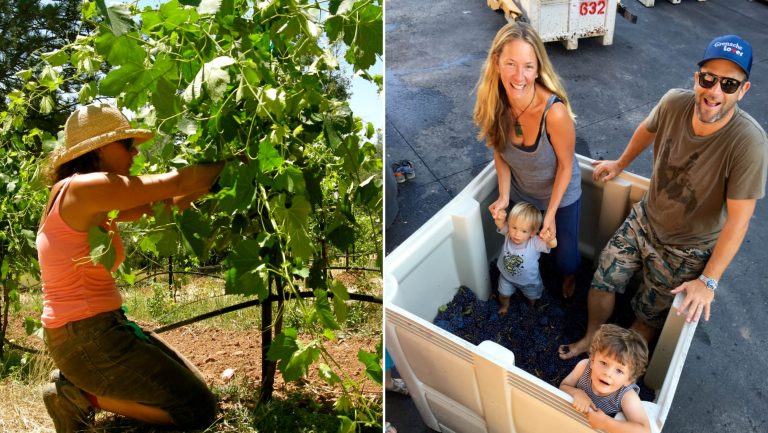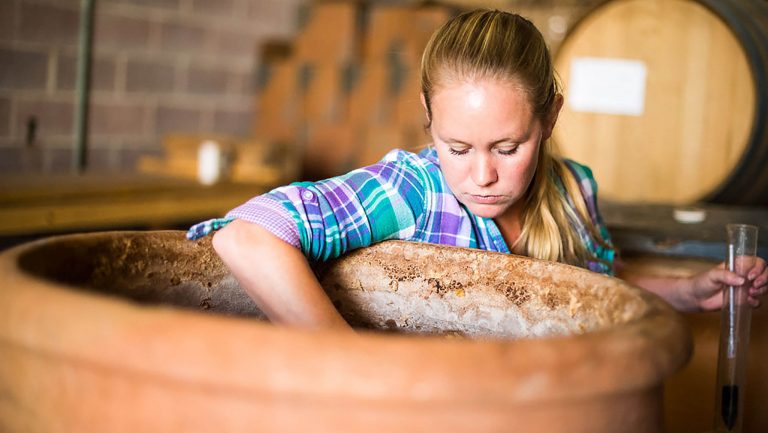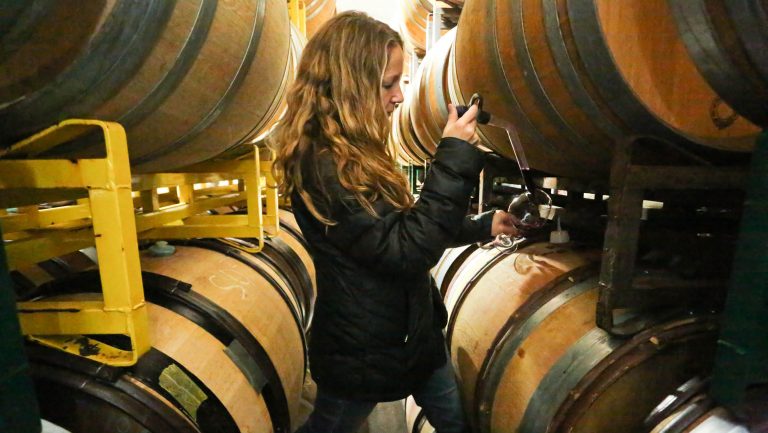California wine may finally be shedding its synonymous association with Cabernet Sauvignon and Chardonnay. A new generation of producers are employing organic, biodynamic, and sustainable viticulture and winemaking techniques and making way for a host of nontraditional varieties, including Vermentino, Trousseau Noir, Mondeuse, and Grenache. But who is making these wines, how are the wines being received by consumers, and what needs to be done to make them sustainable in the market? These were among the topics discussed at California 3.0, a learning session about the new direction in California wine at BevCon 2018, held August 19–21 in Los Angeles.
Moderated by California wine expert and author Jon Bonné, the panel discussion featured four young winemakers who Bonné considers to be among the state’s most innovative—Megan Glaab of Ryme Cellars in Healdsburg, Tegan Passalacqua of Sandlands in Napa, Jaimee Motley of Jaimee Motley Wines in Sebastopol, and Angela Osborne of A Tribute to Grace in Los Alamos—as well as Steven Grubbs, the wine director of Hugh Acheson’s restaurants Empire State South in Atlanta and Five & Ten and The National in Athens, Georgia.
A Shift in the Landscape
Bonné points out that the wine market landscape in California has evolved in a number of interesting ways over the last 10 years. And now, he says, “there is a persistent question of how the world beyond California—and the markets within California—will appreciate these wines, sell these wines, and advocate for these wines.” Though he concedes that many imbibers of California wine are more receptive now than they would have been a decade ago to wines other than the big, oak-driven classics, he suggests that popularizing the new wines may still be an uphill battle.

Don’t miss the latest drinks industry news and insights. Sign up for our award-winning newsletters and get insider intel, resources, and trends delivered to your inbox every week.
“Things are definitely changing,” says Passalacqua, who produces his own Sandlands label while working as the director of winemaking for Turley Wine Cellars in St. Helena. One factor driving the change, he says, is social media and modern technology, which have made wines and vineyards that were once obscure “something that now everyone knows about.”
When Glaab started selling wines from her Ryme Cellars label in 2011, she found that wine buyers were “hungry and desperate for something else.” She says that these days it’s not uncommon for California winemakers to be experimenting with other varieties—“It’s an exciting time to be making wine in California.” Glaab notes that the state’s diverse climates and soil types are conducive to a wide range of grapes and styles. In her experience, she says, “everybody’s mind is open to trying these [new California] wines—and they’re very supportive.”
Motley has also benefited from a supportive California wine community. She works as an assistant winemaker at Wind Gap/Pax Wine Cellars in Sebastopol, and uses the facilities to produce single-varietal Chenin Blanc and Mondeuse (a variety from Savoie) for her eponymous wine label.

Osborne, who relocated to the U.S. from the U.K., says that California gave her a unique opportunity. “I’ve done something here I couldn’t have done anywhere else,” she says. “The culture here truly supports the entrepreneurial spirit.” Osborne, who produces single-vineyard, single-varietal Grenache in vineyards from the Santa Barbara Highlands to the Sierra Foothills, says that in her area of the Central Coast, Grenache is becoming the most planted grape variety. Winemakers, she adds, are pulling out Pinot Noir to plant it.
Challenges for Young Winemakers
Younger producers may be leading the charge in the cultivation of new California wines, but they’re up against some real challenges. There’s a widening gap between landowners and winemakers, says Bonné. The landowners often aren’t the ones making the wine, and increasingly, winemakers don’t own land—and have little chance of ever be able to afford any. “We have some of the absolute best winemaking talent in the state up here [on the panel],” he says, but “the prospect of going out and getting a vineyard and having a traditional winery the way that California once allowed people to do has become incredibly difficult.”
Intrepid winemakers, however, are finding creative interim solutions. The panelists say they’re resorting to things like leasing land to grow their fruit or buying grapes from other growers. Some winemakers, like Passalacqua and Motley, produce their wine at facilities owned by their employers. Others are doing custom crushes, or renting space to process the grapes themselves—or they’re remaining open to the possibility of relocating to a place where they may eventually be able to buy land.
While these solutions are working for the moment, they’re not ideal. Everything from custom crushing to bottles goes up in price from year to year, says Passalacqua, and unfortunately, small winemakers aren’t always able to mitigate those costs by charging consumers a higher price. Born and raised in Napa, Passalacqua thinks the dream of owning land and making wine in Napa is gone. “It’s going to spread people out more to Santa Barbara or Mendocino County,” he says, “where their dream is attainable.”

Bobby Stuckey’s Tips for Finding Balance at Work—and in Life
The Master Sommelier and restaurateur shares strategies for thriving in F&B
Promoting and Selling New California Wines
Glaab is able to produce and release her Vermentino wines fairly quickly. In fact, she feels that she can sell a lot more than she can produce. But selling it in certain markets can be challenging. In New York City, for example, “you can get an amazing $16 or $17 bottle of Vermentino,” she says, “and there’s no way we can make it for that price, retail. But we’ve found that there’s been a lot of excitement around California and what’s been happening, and we’ve really been embraced for that.”
States that observe franchise laws can also pose problems for up-and-coming winemakers looking to sell wine in markets outside California. Grubbs, who is based in the franchise state of Georgia, points out that none of the wines made by the panelists are available in his market. “This [boutique] category is the least represented,” he says. “Thankfully, there’s such a thing as Instagram, because people in Atlanta can at least see these wines.”

Georgia is one of the toughest markets for small producers, says Glaab. “You’re basically married to your distributor, and if it doesn’t work, you can’t get out,” she says, noting that in some ways it’s more difficult to sell her wines in the U.S. than it is to export them to other countries. “Essentially,” she says of the U.S., “it’s like we’re [dealing with] 50 countries.”
Bigger wineries, says Passalacqua, don’t have this problem. They have compliance people and accountants who can manage the legwork. For small producers, it comes down to time and money, and the number of sales that might be made in many of the country’s markets may not be worth it. Passalacqua sells his wines in three states only—California, New York, and Colorado.
The strategy for selling new California wines to restaurants and bars, suggests Grubbs, is definitely a hand-sell. “Zero in on someone on the floor,” he says, “and make them a nerd about them.” The target market, he adds, is younger imbibers who’ve gotten into wine through craft beer and who are open to experimenting with different styles. “I would love,” he says, “to get to the point where we have people [across the country] who like drinking screwy-tasting wines.”

Dispatch
Sign up for our award-winning newsletter
Don’t miss the latest drinks industry news and insights—delivered to your inbox every week.
Jen Laskey is the former executive editor of SevenFifty Daily. She is also an award-winning wine, spirits, and lifestyle writer and editor based in New York City, an associate judge for the IWSC, and a WSET-certified advanced somm and Diploma candidate.






